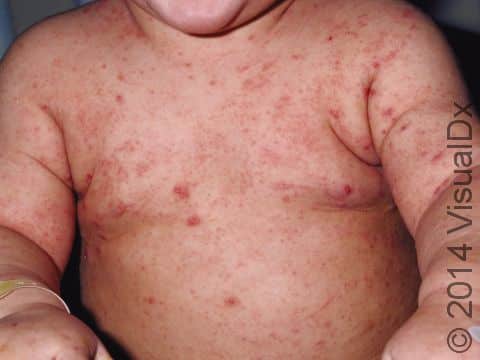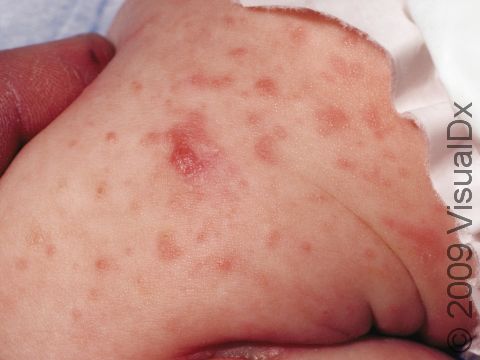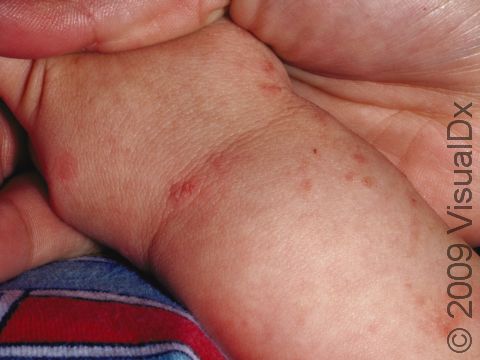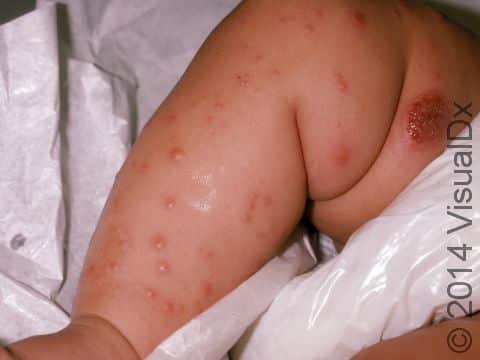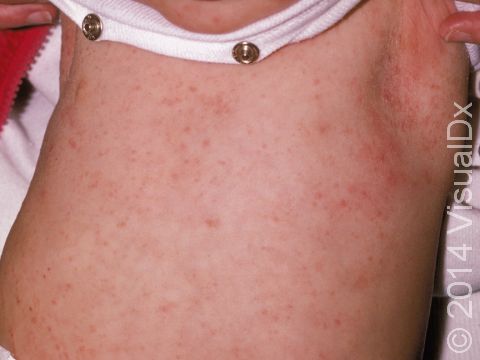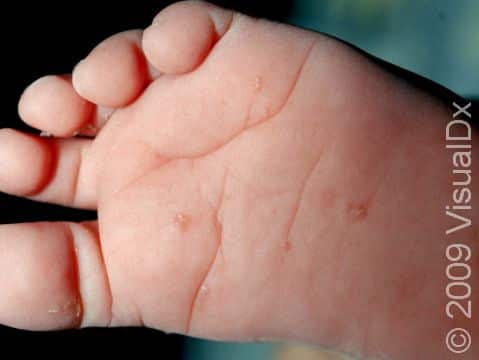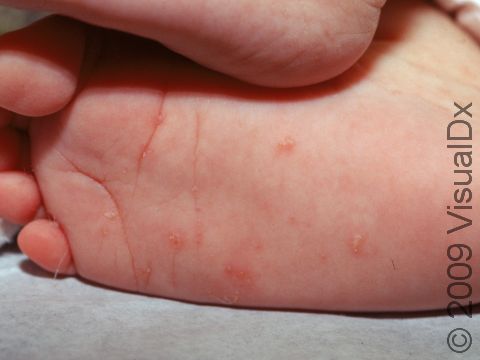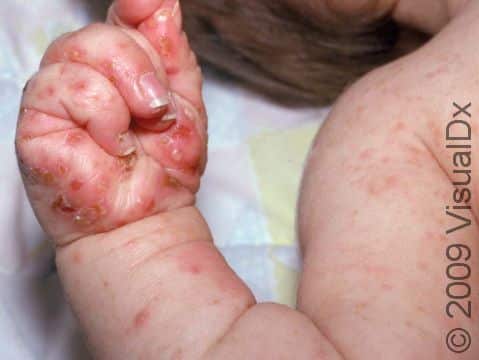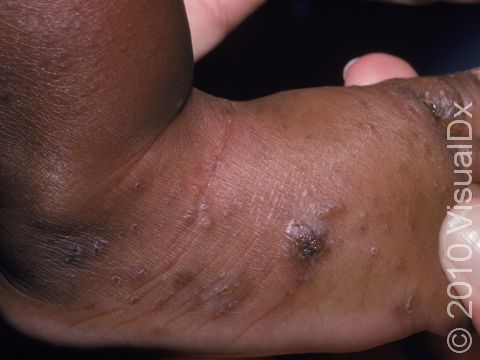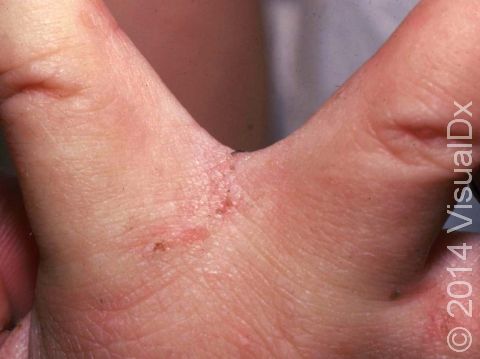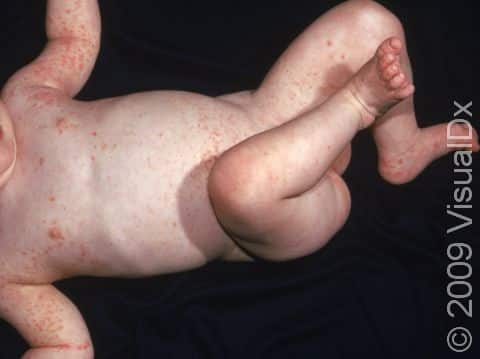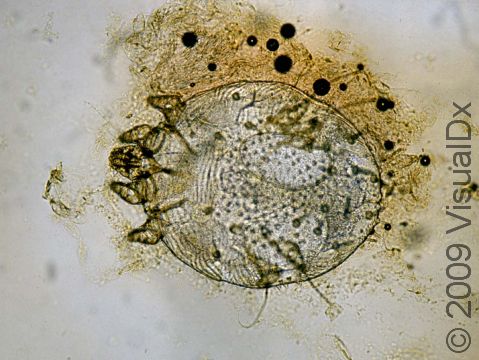Scabies (Pediatric)
Scabies is a common itchy skin condition that is highly contagious. It is caused by a small mite called Sarcoptes scabiei. The itchy rash of scabies develops when a mite burrows into the outer layer of a person’s skin and lays eggs. The human immune system is highly sensitive to the presence of the mite and produces a massive allergic response, which causes intense itching. Although a typical infestation includes only 10-20 mites, people are so sensitive to the mite that hundreds of itchy skin lesions may arise. Without proper medical treatment, the condition will not usually improve.
Who's At Risk?
Scabies can infect anyone, but it is especially common in children younger than 2 years. It can spread rapidly through day cares, nurseries, and within households. Scabies is not caused by lack of personal hygiene, but it is common in people who live in crowded conditions.
Although scabies is extremely contagious, it usually requires prolonged skin-to-skin contact with a person already infested. A quick handshake or hug will not normally spread the infestation. Occasionally, scabies may be spread by sharing towels, clothing, or bedding.
Signs & Symptoms
Although the entire body may itch, the most common locations for the lesions of scabies in babies include the:
- Neck.
- Underarms.
- Diaper area.
- Palms of the hands and soles of the feet.
The most obvious sign of scabies is pink-to-red papules (small, solid bumps). In darker skin colors, the redness may be harder to see, or it may appear purple or brown. In babies, there may also be nodules (solid, raised bumps that are firm to the touch). The lesions may become scabbed over from scratching. The telltale sign of scabies, though, is the burrow, which is a fine, thread-like, scaly line (3-10 mm long), sometimes with a tiny black speck (the burrowing mite) at one end. The rash of scabies can be intensely itchy, especially at night.
Scratching the itchy lesions can create breaks in the skin, and these breaks can become infected with bacteria.
People who are exposed to scabies may not develop itchy lesions for up to 6 weeks after becoming infested, as the immune system takes some time to recognize the mites and develop an allergic response to them. However, individuals who have had scabies before may develop the rash within several days of re-exposure.
Self-Care Guidelines
Scabies requires prescription medication to cure the infestation. Once your baby is being treated, there are measures you can take to remove scabies mites from the household:
- Mites cannot survive off the human body for more than 48-71 hours. Therefore, wash all clothing, bedding, and towels used by the infested person in the previous 72 hours in hot water and dry these items in a hot dryer.
- Vacuum all carpets, rugs, and upholstered furniture, and discard the vacuum bags.
- Put anything that cannot be laundered into plastic bags for at least 72 hours.
Pets do not need to be treated because the mite only lives on humans.
Treatments
The medical professional may be able to diagnose scabies simply by examining the baby’s skin for typical lesions such as burrows. However, they may want to perform a skin scraping, called a scabies preparation, to look for mites, eggs, or mite feces under a microscope.
In most cases of scabies in a baby, the medical professional may recommend a topical cream or lotion, such as:
- Permethrin cream.
- Sulfur ointment.
When using a topical cream or ointment in babies, apply all over the body at night, including the scalp and face, avoiding the mouth and eyes. Putting cotton mittens or socks on the baby’s hands can help prevent them from getting medication in their eyes.
The medical professional may prescribe an antihistamine or topical steroid to help relieve itch. Itching may take up to 3 weeks to go away while your baby’s immune system continues to react to dead mites. However, new burrows and rashes should stop appearing 48 hours after effective treatment.
Household members and anyone else with prolonged skin-to-skin contact with a person with scabies should also seek medical treatment. Since the incubation time for scabies infestations can be from 6-8 weeks, people may be unaware they have scabies. If untreated, these close contacts could pass the mites back to your baby. Ideally, everyone should be treated at the same time to prevent re-infestation.
Visit Urgency
See your baby’s medical professional for evaluation if the baby develops an itchy rash. If other members of the household or close contacts have similar itchy rashes, they should also be evaluated by a medical professional.
References
Bolognia J, Schaffer JV, Cerroni L. Dermatology. 4th ed. Philadelphia, PA: Elsevier; 2018.
Centers for Disease Control and Prevention. Scabies Frequently Asked Questions (FAQs). CDC. https://www.cdc.gov/parasites/scabies/gen_info/faqs.html. Updated 2020 Sept 1.
James WD, Elston D, Treat JR, Rosenbach MA. Andrew’s Diseases of the Skin. 13th ed. Philadelphia, PA: Elsevier; 2019.
Kang S, Amagai M, Bruckner AL, et al. Fitzpatrick’s Dermatology. 9th ed. New York, NY: McGraw-Hill Education; 2019.
Last modified on July 11th, 2025 at 9:44 am

Not sure what to look for?
Try our new Rash and Skin Condition Finder
